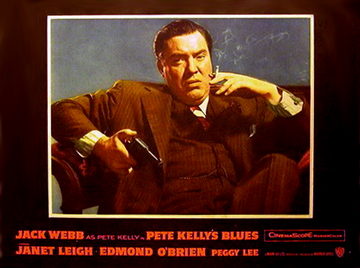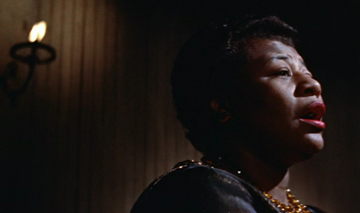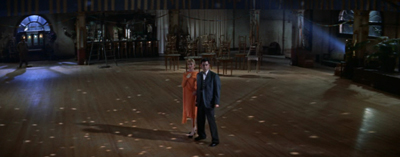
 |
|
|
|
By now Pete Kelly's Blues no longer has to be explained to anyone -- it's a rare occasion when Hollywood showcased musical talent worth putting in a non-musical movie. How often do we see the likes of Peggy Lee and Ella Fitzgerald, singing in color on the big screen? Producer-director-actor Jack Webb was a huge musical enthusiast; we only wish he'd have continued in this vein. 
Character actor Jack Webb hit big on radio and TV by starring in Dragnet, a cop show famous for its stiff direction and deadpan line readings. The TV version validated the commercial prospects of television almost single-handedly. Like a number of Webb's later productions, it was a rubberstamp valentine whitewashing the L.A.P.D.; the "Badge of Honor" show in L.A. Confidential is a direct reference. After starring in a widescreen version of Dragnet Webb got the chance to produce. He turned his attention to his favorite subject, Jazz. Pete Kelly's Blues would become a combination musical biography, gangster film and performance musical. Ella Fitzgerald sings "Hard Hearted Hannah" and the great title tune. In a larger role, Peggy Lee sings "Sugar" and "He Needs Me". Co-star Janet Leigh does okay with the flapper number "I'm Gonna Meet My Sweetie Now" but it's no contest. Unfortunately, Webb's independent producing contract was for acting and directing as well. The handsome Pete Kelly's Blues features solid contributions from a fine cast and every technical department; it should have been the smash of 1955. But Webb is incredibly stiff as the loner bandleader Pete Kelly, killing scene after scene. After years of giving natural, winning performances in great films noir (Sunset Blvd,, Appointment with Danger), Webb locked himself into his perfectly deadly 'Dragnet' style. He often moves like a robot. Instead of acting he hits marks, turns his head and flashes the occasional predetermined smile. Watching the movie is a schizoid experience -- ignore Webb and it's a great picture in the Warner house style, dressed up in flashy period décor, CinemaScope and stereophonic sound. 
It's Kansas City in the '20s. Pete Kelly (Jack Webb) and his Dixieland Jazz band the Big 7 are getting bookings, so Pete's socialite / flapper girlfriend Ivy Conrad (Janet Leigh) can't understand why he's balking at marriage. Then gangster Fran McCarg (Edmond O'Brien) takes over Kelly's management and forces him to work with a singer, Rose Hopkins (Peggy Lee). Fran's cruel treatment has turned Rose into a neurotic lush, and she often chokes up on stage. McCarg's presence also causes trouble with some of Pete's musicians, including Al Gannaway and Joey Firestone (Lee Marvin & Martin Milner). Some quit and one is murdered for speaking out against the crooks. Cornered, Pete decides to join forces with Federal cop George Tenell (Andy Devine) and fight back. First-time viewers of Pete Kelly's Blues are often impressed by its dynamic, directional stereophonic audio. In the late 1940s the Warner Sound Department concocted a particular recording method that gave their orchestras more brass and more bite, whether for a big picture or a Bugs Bunny cartoon. When multi-track magnetic audio came along, the stereo tracks for shows like A Star is Born were overpowering. 1 
The movie is a visual treat as well. It begins with a beautifully realized prologue at a New Orleans funeral that explains where Kelly got his cornet -- unlike Rock 'n' Roll, white Jazz musicians readily acknowledged that they were inspired by black musicians. The carefully designed shots segue into the title sequence with an authority not found in MGM musicals, all glued together with Ray Heindorf's powerful title tune. The movie saves its clever sets for violent confrontations -- a rainy alley, a secret meeting place in the attic of a roadhouse. The concluding gun battle takes place in an empty, echo-y dance hall with a calliope playing and a glitterball throwing light in all directions. Although director Webb gets the credit for these scenes, all were planned and storyboarded by production designer Harper Goff. Famous for his futuristic submarines for Walt Disney and Richard Fleischer, Goff has a small role in the film as an enthusiastic banjo player at Janet Leigh's wild party. Are the many unusual shots in the movie Goff's doing? Billy Wilder would have criticized a camera angle taken from inside a flaming pizza oven. A scene in Kelly's room is taken from behind a shelf that belongs against a solid wall, but the wall is missing. We do admire one particular insert. A cut from a wide angle gives us a huge CinemaScope close-up of a bin of macaroni. Kelly's giant hand reaches in to pull out a .38 revolver. Webb clearly deserves credit for putting all of this talent together, and it's a shame that he doesn't do better with his Pete Kelly character. Webb's idea of cool is Humphrey Bogart, yet he stands like a statue with the same dull weary expression on his face. The only actor more rigid is Charles Bronson. The other actors must play to a dramatic hole in the screen. Pros like Edmond O'Brien and Janet Leigh work up a lot of energy and Webb gives nothing, or less than nothing. It looks like he's thinking, "Everybody better hit their marks and pick up their cues or I'm going to be mad." The script is engineered so that everyone either loves or respects Kelly, but we're not sure why. Kelly has a pet bird that loves him, but he's also a tough guy. Things get really silly when Webb's character punches out supporting actor Lee Marvin -- twice. Marvin's passive character takes this as a sign of friendship, apparently. 
A band called Matty Matlock's Dixielanders plays Kelly's Big 7. The music sounds authentic and Arthur Hamilton's new compositions are excellent. Ray Heindorf's main theme sounds great on trumpet and even better when belted out by Ella Fitzgerald, who stops the show. Webb lets the movie pause whenever she or Peggy Lee sings, a wise choice. The musical numbers may now be more popular than the film itself. Peggy Lee was nominated for an Oscar in this show. Her Rose Hopkins is a bald reprise of Claire Trevor's Oscar- winning turn as a songbird-lush in John Huston's Key Largo. As much as we worship Lee's singing, she's weak in the acting department. She has to carry whole scenes with Webb standing there like a wooden Indian. Her asylum scene is supposedly what got her the nomination, but it's just terrible. The set is doing all the acting. Even if one spends time mentally re-casting the Kelly role, there's plenty to like in Pete Kelly's Blues. Both Andy Devine and Lee Marvin take on atypical parts. We also get a peek at Jayne Mansfield in her first feature appearance, just before she reinvented herself as a vulgar blonde bombshell, a cartoon character. In her small role as a cigarette girl she seems completely, well, normal. 1 Pete Kelly's Blues is a recommended musical-gangster film with interesting period touches and a terrific soundtrack. It's a shame that more great musical performances weren't integrated into '50s films as they are here. All the right elements were in place to create a classic. And what could be cooler than that final "Mark VII Productions" logo at the end, the one with the big sweaty hand and the iron mallet? Terrific. 4 
The Warner Archive Collection Blu-ray of Pete Kelly's Blues looks good in HD. Most of the Warner Color has survived without turning brownish, all except for the prologue on the Louisiana Bayou. Most of those scenes are opticals, and the different film stock used would have faded differently than the rest of the film. 2 Cameraman Harold Rosson lights the standard Warner back lot sets for maximum drama. He clearly works hard to minimize the "CinemaScope Mumps", but a few shots still stick out. Some combination of Rosson, Goff, and Webb came up with great compositions for the extra-wide 2:55 screen. The audio is again a 5.1 remix, made from a surviving four track magnetic release print that was recovered in the 1990s. It's brassy and bright, with pronounced separation on sound effects. 3 
The extras repeat a pair of short subjects from the 2008 DVD release. Robert Youngson's Gadgets Galore is a compilation of silent film footage about the evolution of the automobile, updated with a comedy soundtrack. The Robert McKimson cartoon The Hole Idea is the good one about the professor who invents a 'portable hole.' Two original trailers are included in which Jack Webb introduces the movie and his cast -- we even get a close-up of the CinemaScope camera and Harold Rosson. The cover art uses an original poster design from the movie.
On a scale of Excellent, Good, Fair, and Poor,
Pete Kelly's Blues Blu-ray rates:
Footnotes:
1. Just the next year, Jayne Mansfield would star in Frank Tashlin's comedy opus The Girl Can't Help It. Its scattershot satire uses the same basic idea as Pete Kelly's Blues -- Edmond O'Brien repeats as a mobster (albeit a funny one) boosting the career of a singer who can't sing (Mansfield).
2. Webb begins with a long panning shot with "New Orleans 1905" superimposed. That means that the whole shot is an optical, which increases grain and contrast and softens the image. Compare this with the beginning of John Ford's The Searchers, which isolates its 'time and place' text card in black, just before a door 'opens onto the West'. Both movies surely looked terrific in original Technicolor prints, but it's unlikely that optical negatives for texted scenes were retained, after versions in French, Spanish, etc., were made. So the film restorers for Kelly must start with a slightly degraded opening shot.
3. Most of Warners' 1950s stereophonic sound elements had been destroyed by the time home video came around. But as part of the copyrighting process, Warners had filed original prints of all their films with the Library of Congress. In the early 1990s, before organized studio restoration departments sprang up, a producer hired to do special research went to Washington D.C. and practically camped at the LOC until the librarians came through. The original copyright prints of the majority of Warners' films were indeed there, in some cases never screened, including those with original 4-track magnetic stereophonic sound. This is how stereo tracks were recovered for the films Land of the Pharaohs, East of Eden, Rebel Without a Cause and many others.
4. I'm definitely not averse to Jack Webb, especially not in Dragnet. He's fun to watch here as well. The makers of ultra- low budget TV series like Dragnet and Highway Patrol contracted to make dozens of half-hour episodes for each season, sometimes with no Network money up front. To make it work, they devised a system in which an entire season could be shot in record time, on an assembly line. If twenty of the season's scripts have Joe Friday and his partner visiting a police superior, those scenes will all be shot at the same time, hiring that actor perhaps for just a day or two. Most of the second-unit shots of cars driving (seen behind radio-style voiceovers) were scheduled in one shoot. Some actors may be filmed talking to Friday, but without him present; Friday and his partner were filmed against generic walls, in marathon dialogue scene for all the scripts, all at once. This is why Friday talks in a monotone -- when he speaks that way, dialogue always matches even when opposite halves of the conversation are filmed separately. Joe Friday always wears the same clothes so no continuity mismatches will crop up. The show is almost filmed radio. The specialness of each episode is almost completely due to the personalities playing the various civilians Friday interviews. I'll bet that Webb used the same techniques throughout his TV career.

Reviews on the Savant main site have additional credits information and are often updated and annotated with reader input and graphics. T'was Ever Thus.
Review Staff | About DVD Talk | Newsletter Subscribe | Join DVD Talk Forum |
| ||||||||||||||||||